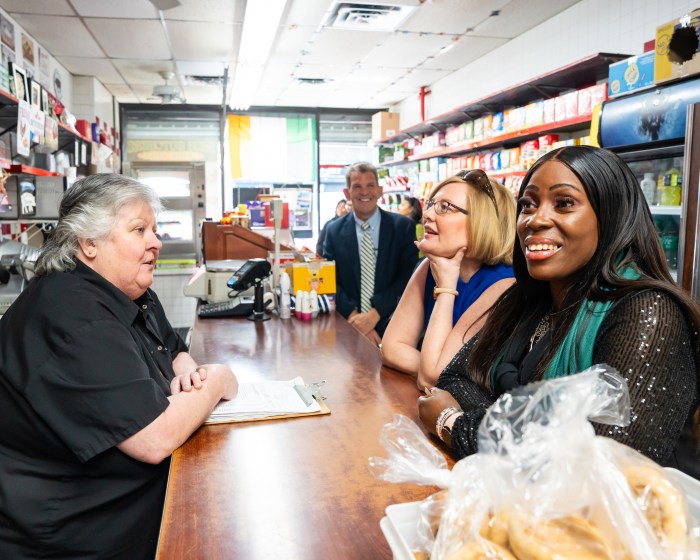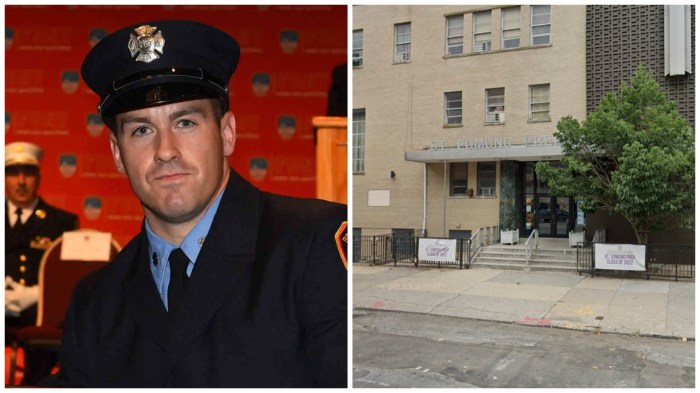New Yorkers like Vision Zero, Mayor Bill de Blasio said last week on the Brian Lehrer Show.
He was referring to his multipronged effort to make streets safer for pedestrians, bikers, and drivers, an initiative begun in 2014 to reduce the number of New Yorkers who die yearly in traffic crashes. The number of fatalities has decreased in recent years, but still hovers around 300.
Vision Zero includes design changes — building pedestrian islands in the middle of long crosswalks, reducing speed limits — and advertising campaigns, which highlight the choices that drivers make behind the wheel.
But on the radio show, de Blasio was drawing a comparison between traffic safety and a controversial policing strategy, being debated anew in the wake of a newly released city report: “If you like Vision Zero, that’s part of broken-windows too,” he said on Thursday.
Reclaiming broken-windows
It makes sense that de Blasio would try to draw an analogy with Vision Zero.
The initiative has been fairly successful so far: In January, de Blasio announced that 2015 was the safest year on record for NYC streets, with 231 traffic fatalities.
Some might grumble about having to watch the speedometer or navigate around street construction and bike lanes, but in general the initiative is pretty good politics. Little downside, lives saved. (Last week a Queens court challenged a portion of Vision Zero’s enforcement mechanism, though that issue is ongoing).
Broken-windows, on the other hand, has become the third rail of NYC and urban politics in general.
Depending on who you ask, broken-windows policing saved cities across America from waves of crime and urban decay when it was launched in the 90s. Or it represented an attack on minority communities that continues to sweep predominately black and brown citizens into the criminal justice system, criminalizing behavior that’s commonplace in other neighborhoods.
The theory behind broken-windows, popularized in a 1982 Atlantic article by social scientists George Kelling and James Q. Wilson, is that the prevalence of minor quality-of-life crimes gives the impression that major crimes will be similarly tolerated.
Last week, a new study from the city’s Department of Investigation and the NYPD’s independent inspector general provoked questions about the link between quality-of-life enforcement and the decrease in major felonies that is at the heart of broken-windows policing.
The report stresses that quality-of-life enforcement can be useful for its own sake — to cut down on quality-of-life offenses that communities decide need to be enforced. And the report doesn’t try to make any definitive statements about the history of the policy. But in the past five years, quality of life enforcement has dramatically decreased and major felonies have not run rampant in NYC — rather, they’ve fallen too.
The NYPD quickly dismissed the report, questioning the short time scale. De Blasio, too, stood by his police commissioner, defending a policing strategy that many of his liberal allies would prefer he distance himself from. And as he has a few times in the past, he pointed to Vision Zero as an apolitical, accepted version of broken-windows.
Broken-windshield policing or something different?
De Blasio claims that his implementation of broken-windows is an evolved crime-prevention strategy, and as unbiased as issuing traffic tickets. You discourage people from their bad habits of speeding, making reckless turns, and you save lives.
Unfortunately, it’s a faulty analogy.
Vision Zero enforcement might be policing recklessness before it leads to a fatality, but that recklessness is the thing that causes fatalities.
The city is not making an assumption that a minor violation leads to a major crime — that the public drinker is also the mugger, for example. It is policing crimes that endanger people.
In fact, the Vision Zero analogy, properly framed, should be a model for 21st century policing, in a very different NYC than existed in the 90s.
Enforcement is one portion of the initiative, but it’s paired with real investment to infrastructure and education, making streets safer and more convenient for their denizens. And the enforcement focuses on the crimes.
Nobody wants dangerous streets, be it from cars or crime. The city just wants strategies that match modern realities.
This is amExpress, the conversation starter for New Yorkers. Subscribe at amny.com/amexpress.

















